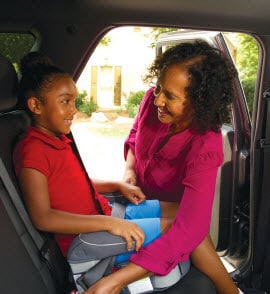ICRC Research Impact: Preventing Youth Sports Concussions
Just the facts
More than 7 million U.S. students participate in high school sports each year. Although these young athletes realize many positive benefits, they also increase their risk of injury, including concussion. Over the past decade, the short- and long-term physical, cognitive, and emotional consequences of concussion have gained widespread national attention. Although most sports-related concussions have health-related outcomes of limited severity, more serious outcomes can include long-term neuropsychological dysfunction, dementia later in life, or even death.
What we know about prevention
Despite recent advances in the diagnosis and management of concussion, more information is needed about how to most effectively prevent these injuries. As strategies are designed and tested, reliable surveillance information is needed to evaluate their impact and effectiveness. Without such data, sports governing bodies considering rule changes, researchers studying risk and protective factors, clinicians managing injuries, coaches teaching sports techniques, and groups developing educational materials for parents and athletes can only rely on information from adult athletes, occasional anecdotes relevant to high school athletes, or emotional arguments. Information specific to young athletes must drive efforts to improve their health and safety.
Designing High School RIO™
In 2004, High School RIO™ was designed and tested by the Center for Injury Research and Policy (CIRP) at Nationwide Children’s Hospital. Since its inception, this large nationally representative surveillance system has captured detailed case reports on more than 70,000 injuries among athletes participating in 22 different high school sports. For each injury, athletic trainers providing care to these high school students report information about the injured athlete (age, gender, sport played, etc.), the injury (severity, diagnostic tools employed, types of clinicians involved in care, etc.), and the injury event (mechanism of injury, specific sport activity during which injury occurred, types of protective equipment worn, etc.).
Using data to educate and inform policy
In addition to creating the database and collecting the data, concussion information has been shared actively with researchers, clinicians, policy makers, and sports governing bodies through more than 15 peer-reviewed medical journal articles and more than 40 presentations at national scientific meetings. For the first time, these data allow a full description of the rates of concussion among young athletes by sport and gender. Among other findings, they reveal differences in concussion symptoms reported by girls and boys that a substantial number of high school athletes fail to comply with return-to-play guidelines following concussion, and the potential effectiveness of a heading ban for young soccer players.
As a result of CIRP’s active dissemination of information and data, High School RIO™ has also played an important role in educating millions of coaches, parents, and young athletes through the mass media, including stories in nearly all the major U.S. television, radio, and print outlets. A 2007 New York Times article, citing the first High School RIO™ publication, first alerted the public to this critical problem, generating concern that has only grown since. This lay audience demanded that young athletes be kept safe from brain injury, catalyzing action from public health policy makers and sports governing bodies alike in the form of legislation, rule changes, and educational efforts. Starting in 2009, Washington became the first state to require “removal and clearance for Return to Play” among youth athletes. Now all 50 states have a “Return to Play” law to help protect young athletes.
Leading networks for change
Over the past decade, key partners, supporters, and collaborators have been involved with High School RIO™. Most notable are the CDC’s Injury Center, the National Federation of State High School Associations, the National Athletic Trainers’ Association, the National Operating Committee on Standards for Athletic Equipment, and several national sports governing bodies. Data are now being used to evaluate several new policies: state-level sports concussion legislation guiding removal from play and return to play policies, recommendations to limit full contact drills in football practice, and state rules requiring helmets to be worn by female lacrosse players. Beyond collecting high-quality, relevant data, CIRP’s education and dissemination efforts are having a meaningful impact on the prevention and control of youth sports concussions.
To learn more:

